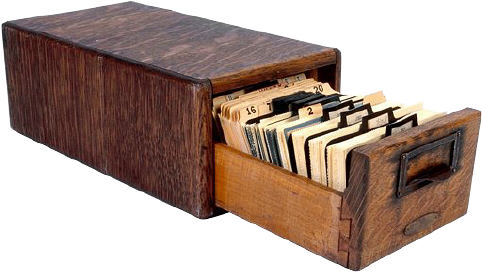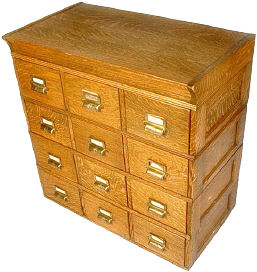A typical citation provides a book's
title and subject, author, publisher, copyright, publication
date; it lets a visitor know whether it's a work of fiction or non-fiction.
A citation may also give a description of a book's contents.
Armed with this knowledge, with the assistance of a librarian, a
visitor is equipped to find the cited book on the shelf and look through it before
finally deciding whether to check it out.
If the visitor decides to check the book out, the librarian pulls the
book from the shelf and brings it to the desk on a library cart, usually
with other books for other visitors, and signs them out. The librarian also
uses the cart to file returned books on the shelf.
A book mentioned in a citation is a holding and a library's
collection of books is referred to as its holdings. Holdings are not
citations; citations describe holdings. Holdings are the books, maps,
pictures, and other resources stored on the library's shelves, usually in
another part of the building, not in the part of the building where the
catalog resides. Books and other holdings are shunting back and forth
between the Front Desk, where patrons sign out books, and the shelves in
other rooms where holdings are stored. Sometimes a book mentioned in a citation belongs to
the holdings of another library, from which it can be borrowed.
 In a traditional library, citations are kept in a library's card catalog, where visitors can take a
close look at them. Before computers came of age, citations typically were printed on 3X5 cards;
the cards were stuffed into long and narrow drawers which were crammed next to each other,
row upon row, into the gliders in a wooden or metal cabinet. The collection of
3X5 cards in drawers is called the library's card
catalog. Today, some libraries still store citations in a card catalog;
but more and more, libraries are storing citations in electronic databases.
In a traditional library, citations are kept in a library's card catalog, where visitors can take a
close look at them. Before computers came of age, citations typically were printed on 3X5 cards;
the cards were stuffed into long and narrow drawers which were crammed next to each other,
row upon row, into the gliders in a wooden or metal cabinet. The collection of
3X5 cards in drawers is called the library's card
catalog. Today, some libraries still store citations in a card catalog;
but more and more, libraries are storing citations in electronic databases.


 In a traditional library, citations are kept in a library's card catalog, where visitors can take a
close look at them. Before computers came of age, citations typically were printed on 3X5 cards;
the cards were stuffed into long and narrow drawers which were crammed next to each other,
row upon row, into the gliders in a wooden or metal cabinet. The collection of
3X5 cards in drawers is called the library's card
catalog. Today, some libraries still store citations in a card catalog;
but more and more, libraries are storing citations in electronic databases.
In a traditional library, citations are kept in a library's card catalog, where visitors can take a
close look at them. Before computers came of age, citations typically were printed on 3X5 cards;
the cards were stuffed into long and narrow drawers which were crammed next to each other,
row upon row, into the gliders in a wooden or metal cabinet. The collection of
3X5 cards in drawers is called the library's card
catalog. Today, some libraries still store citations in a card catalog;
but more and more, libraries are storing citations in electronic databases.

